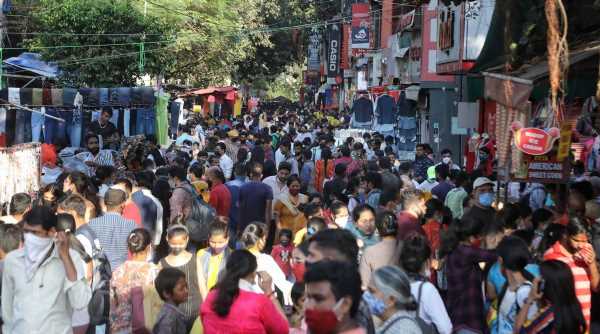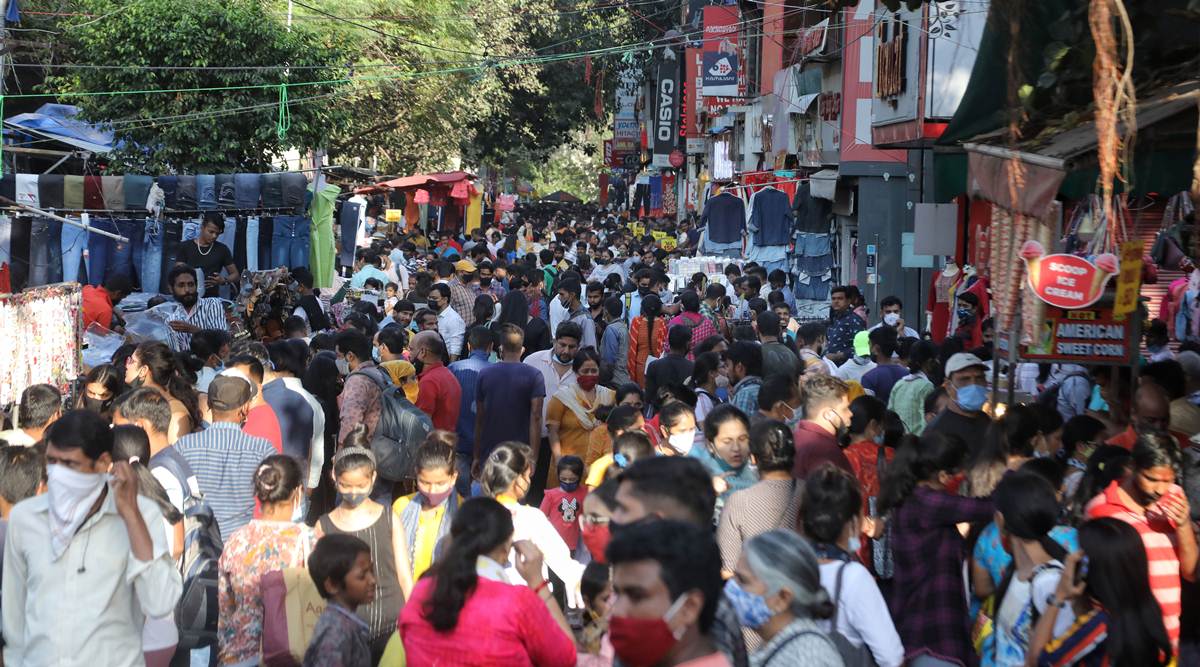On October 9, two days after Navratri began, Union Health Minister Mansukh Mandaviya held a meeting with officials of 19 states and union territories to discuss measures being taken to contain the spread of infection during the festival season.
THERE WERE few masks, no thermal screening at entry points and zero social distancing.
The images of crowds thronging Delhi’s popular Sarojini Nagar market Thursday for the festival season, which will run till the end of the year, have revived fears of another Covid surge.
In fact, the chief of India’s Covid task force has already issued a grim warning.
“India has administered at least one vaccine dose to almost three-fourths of its adults. We need to achieve saturation coverage with two doses at the earliest. But, at this juncture, we also need to continue to follow all preventive precautions. Vaccine alone is not enough. There cannot be large gatherings. Let us celebrate festivals at home with the family. We cannot lower the guard and have to adopt Covid-appropriate behaviour. We cannot let the pandemic situation go out of control,” Dr V K Paul told The Indian Express.
“Vigilance and vaccines are both critically important in the next three months,” he said.
This message, Paul said, is being continuously reinforced in communications with the state governments and local administrations.
On October 9, two days after Navratri began, Union Health Minister Mansukh Mandaviya held a meeting with officials of 19 states and union territories to discuss measures being taken to contain the spread of infection during the festival season. He emphasised that the festivals, which are “synonymous with auspiciousness, joy and large gatherings”, might “derail the containment of Covid19” if they were not celebrated “in accordance with Covid protocols”.
On September 21, Union Health Secretary Rajesh Bhushan had sent a detailed communication to all the states asking them to maintain utmost vigil during this “critical period”.
“There may be a tendency to ignore Covid-safe behaviour during the festivals resulting in large gatherings, events, fairs,” Bhushan wrote. “It is critical to enforce adherence to guidelines to allow festivities in a cautious, safe and Covid-appropriate manner. Any laxity in implementation of Covid-appropriate behaviour could lead to serious consequences and can result in a surge in cases,” he said.
“As a matter of abundant caution”, Bhushan’s communication asked the states not to allow “mass gatherings”. Only in districts with a positivity rate of less than five per cent, should a “limited number of people” be allowed to gather and assemble, and that too with prior permission from the district administration, it said.
During the October 9 meeting, Bhushan stressed on three important measures: provision for online darshan at all important shrines, “symbolic” observation of rituals, and provision for separate entry and exit points wherever gatherings were allowed.
Officials say the situation is critical, especially with tourism expected to take off now with airlines all set to operate at full capacity from next week and the Government deciding to start granting fresh tourist visas to foreigners arriving on “bubble flights” from November 15.
In July, as cases began to decline, domestic tourists started visiting popular sites in large numbers, leading to a surge in many places.
In states, the withdrawal of restrictions during festivals in Kerala led to a rise in the infection rate. Some places in Maharashtra and Gujarat reported an uptick after the recent festivities.
For the last one week, the daily count of fresh cases has dropped below 20,000, a situation that was last seen in late February and early March, just before the explosion of the second wave. Several states, even large ones, have been reporting less than ten cases a day.
Officials point out that the vaccination drive has covered a large proportion of the population. Close to 70 crore of the nearly 93 crore people above the age of 18 years have received at least one dose — nearly 28 crore are fully vaccinated.
But they are keeping their fingers crossed. Even a few super-spreader events, they warn, could initiate a chain reaction that could put India’s daily case count back in the 40,000-50,000 range.
Source: Read Full Article


